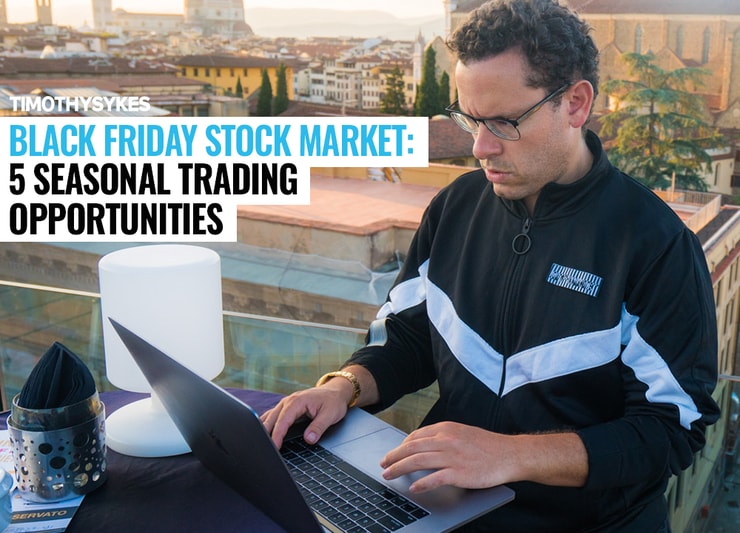Black Friday. Turkey and pumpkin pie hangover. I bet your email inbox is exploding with deals. Maybe you’re one of the millions who stood in long lines this morning.
Personally, I’d rather stay away from the madness and wait for Cyber Monday. It’s a lot easier. And safer.
If you did risk the Black Friday throng, I hope it was to get yourself a new trading computer or something really useful for your life.
If you’re out there now …
… don’t be the jerk who tackles the old lady to get the big screen TV before they run out of stock!
That’ll get you on the evening news in a bad way. Here’s a better way: Join my Trading Challenge, then hopefully get on the news because you’re a badass trader.
Whatever your Black Friday plans, stay safe and be kind to others. The last few years have been total madness.
Table of Contents
What is Black Friday?

Did you know the first-ever Black Friday was a financial market crash? More on that later.
We think of Black Friday as the biggest retail shopping day of the year. It’s the official start of the holiday shopping season and most stores have massive sales. Many people also have the day off from work.
Some stuffy financial types think Black Friday is based on an old accounting practice. Accountants used red ink to list losses and black ink for profits. They believe Black Friday sales help retailers get ‘in the black’ for the rest of the year.
While day-after-Thanksgiving sales have been going for decades, the use of the term Black Friday wasn’t widespread until the 1980s. In some parts of the U.S., it wasn’t until the 90s. Before that, it was a negative term used by some traffic cops in Philadelphia.
In the 1950s, Philadelphia cops started calling it Black Friday because they got stuck with 12-hour shifts every year. The reason was a huge increase in traffic from shoppers and fans of the annual Army vs. Navy football game.
It spread from there into what we now call Black Friday. Anyone with a pulse and an email account has been inundated with Black Friday advertisements for the last week.
With companies like Amazon selling in many countries around the world, Black Friday has spread. It’s even a big shopping day in countries where they don’t celebrate Thanksgiving or have Friday off work. In other words, it’s become a marketer’s dream.
Economic Importance of Black Friday
Whatever you think of the whole Black Friday phenomenon, it’s pretty clear a big pile of cash changes hands. But how important is it for the economy? We’ve been led to believe that without Black Friday many retailers would go bust.
Like so much other BS out there, this narrative is not very accurate. Most profitable retailers are profitable throughout the year. If a business needs Black Friday and the holiday season to be profitable, they’re already in trouble.
Black Friday does kick off the holiday shopping season. It also gives retailers a good idea of what’s selling and what’s sitting on the shelves collecting dust. Be wary of the so-called discounts: Rumor has it they actually create products specifically for Black Friday now. It’s become that big of a deal.
Influence of Cyber Monday
Cyber Monday became a ‘thing’ back in 2005. Some marketing honchos realized that the Monday after Thanksgiving was a huge online shopping day. Presumably, because weekend window shoppers went back to work and had access to high-speed internet.
Online shops were already angling for a ‘day’ they could call their own. They tried White Wednesday back in 2003. That one didn’t stick — maybe because online shoppers wanted to do some window shopping over the weekend.
In any case, Cyber Monday is the real deal. Year on year, Cyber Monday is growing faster as a shopping day than Black Friday. Cyber Monday is now a massive online shopping day in at least 16 countries around the world including the UK, Japan, Sweden, Germany, and Australia.
This Day in History
Marketing has turned almost any day of the year into an event. It’s kind of bizarre if you ask me. But hey, whatever. This year’s Black Friday date — November 23 — is pretty interesting for traders.
Today is Fibonacci Day. It’s always on the 23rd because the numbers 1-1-2-3 in the date 11/23 form a Fibonacci sequence.
In case you don’t know, Fibonacci was an Italian mathematician from Pisa who lived in the middle ages. Some of his ideas are used, to this day, by traders.
If you have a decent stock charting setup you can use a Fibonacci Retracement as a technical indicator. Personally, I don’t use it, but that doesn’t mean it’s not valid.
I don’t want to leave out this year’s date for Cyber Monday — the 26th of November. It’s International Cake Day. So when you are sitting there at your trading terminal on Monday and you need a break, eat some cake.
When you become a badass trader you still can’t have your cake and eat it too — but you can buy more cake!
Black Friday and Stock Market History
1929 Crash — Black Thursday to Black Tuesday
I’m guessing you studied the Great Depression in your high school history class. If so, you know at least a little about the stock market crash of 1929.
The roaring 20’s were a time of wealth and exuberance — and a lot of speculation. Even though the setup for the crash was over several months, the first big day was Thursday the 24th of October, 1929. It’s now referred to as Black Thursday by stock market historians.
There was almost a rally as some very wealthy bankers bought up a bunch of shares above current market price. But even with the injection of millions of dollars into the market, the Dow Jones Industrial Average still closed down for the day.
On Friday the 25th the rally continued. But over the weekend, news of market turmoil spread across the country. At that time, the markets were open for a half day of trading on Saturdays. By Black Monday, most of the country was in a panic.
The worst was yet to come. On what’s become known as Black Tuesday…
… the market crashed big time.
As a percentage of total value, it’s the biggest single-day drop in history. You know it as the beginning of 12 years of worldwide depression. The market remained in full bear market mode (downtrending) until July of 1932. By that time it had lost 89% of its pre-crash value!
Black Friday 1869
Now we come to the very first reference to Black Friday. This one is really interesting to me because it played out almost like a pump and dump that got screwed by the federal government.
Speculators Jay Gould and his partner James Fisk decided they were going to corner the gold market. After the Civil War, to trade gold and the newly created Greenback paper currency, the New York Gold Exchange was formed.
These two greedy bastards conned the President — Ulysses S. Grant — by getting close to him. They did it through another speculator who happened to be married to Grant’s sister. You really can’t make this stuff up. It’s like a soap opera. We seem to have a lot of that in our history …
Anyway, they managed to con the president to influence the Treasury into not selling gold. At the same time, they bought up all the gold bullion they could. Boom. Prices skyrocketed. Supply vs. demand. Low supply, high demand — prices shoot up.
But they screwed up. Grant found out about their plan and instructed the Treasury to sell gold. Lots of gold. What did I just say about supply vs. demand? You got it — high supply starts to bring the prices back down.
The government flooded the market with around $4 million worth of gold on one day. That’s huge in today’s money. It was Friday, September 24, 1869. Black Friday. What do you think happened next?
That’s right — the Black Friday stock market crash. First the gold exchange crashed, then Wall Street panicked. The country went through a few months of economic turmoil but, by and large, the move by Grant’s administration managed to avert a depression.
Those two swindlers? They escaped prosecution. An 1870 government investigation also cleared Grant of any wrongdoing.
It seems we’ve been bailing out financial scammers for a long time …
Is Trading Stocks a Good Idea This Time of The Year?

Now you know a bit of the history of Black Friday — both as a stock market event and as a shopping event. The question arises…
… Should you be trading this time of year?
Black Friday Stock Market Hours
First things first: the stock market takes days off just like the rest of us. It’s closed for Thanksgiving and open half day (until 1:00 pm Eastern time) on Black Friday. Since you are gaining knowledge to become a trader, you should keep the holidays and trading hours handy.
5 Seasonal Trading Opportunities
1. The January Effect
People ask me about the January Effect and tax loss selling. What does it mean and how is it a trading opportunity?
If you have a big loss on an investment and you take the loss before the end of the year, you can write the loss off on your taxes.
Just a sec … I have to please my lawyers…
DISCLAIMER: I am NOT an accountant or financial advisor. Get professional advice.
Ok, I’m back.
So what happens is that people sell off stocks they’ve taken losses on and then buy them back in January. This makes a lot of stocks go up in price in January. Particularly small-cap stocks.
As a trader, you can take advantage of the January effect by anticipating the phenomenon.
How do you do it?
- Start looking for low-priced stocks selling off (and falling in price) at year’s end.
- Keep stocks you identify on your watchlist. Keep watching them into January. Here’s how to get my weekly watchlist.
- Look for these stocks spiking on higher than normal volume in January. You can possibly ride the wave as those who sold for tax loss reasons open new positions. Also, other people will have the psychology of “this is a January effect play.” It becomes self-fulfilling. Your job is to take advantage of it.
Remember, it’s not an exact science — but it is a trend.
2. The Return of the Bear Market
Here’s something to look for in the Black Friday stock market …
As of writing (I’m penning this a few days before Black Friday so I can take a little time off to be with family), we’re not officially in a bear market — but we’re getting close. Over 40% of the stocks in the S&P 500 are in bear market territory. A bear market is defined by a loss of 20% from recent highs. All the FAANG stocks mentioned in number 4 below are in bear territory.
By the time you read this, we may be there. If Morgan Stanley’s correct, we’re already there. On November 19, the powerhouse investment bank declared that we are, indeed, in a bear market.
What does this mean for trading? Short sellers can potentially make huge amounts of money. I teach my Trading Challenge students short selling. It’s one of my favorite strategies.
For more information, check out this post about how to survive a bear market (you can see me in a silly picture, as well).
3. Short Stock Market Hours
Believe it or not, short hours can be a good opportunity.
Since you want to be a day trader, you need to know that the first half hour and last half hour of the day have volume spikes. Lots of traders get in and out based on news and trying to close positions at the end of the day.
On a short trading day, you have to be aware this is going to happen early. Black Friday, in particular, seems to be a positive day for the market historically. Overall trading volume is down because many traders take the day off. But those who do trade seem to be in a jolly mood and there’s a history of markets going up.
4. Fall of the FAANG Stocks
There are a few talking heads — finance show pundits —- squirming in their seats over this …
Do you know what the FAANG stocks are? Facebook, Amazon, Apple, Netflix, and Google. They’ve taken a shellacking this week … this month … and this year.
As of writing, they’ve lost over $1 trillion(!) in market capitalization since their recent highs. Facebook alone is down 40%. It’s not surprising after the data protection troubles they’ve had.
What does this have to do with anything? If you’ve been following the amazing bull market we’ve had for the last decade, you might already know this. Those five stocks have carried the load. They’ve propped up the entire market as they blew up in value.
Some say they were incredibly overvalued when you look at the fundamentals. Others say now is the time to jump in and buy. But I don’t trade these kinds of stocks so why am I bringing this up?
It’s like this: When you have a group of stocks carrying the entire market on their back, they create a microcosm of market sentiment. How they fare is often how the overall market fares.
While I trade penny stocks and I look for certain patterns, overall market sentiment can have an effect on what types of plays are available.
So right now, as the big boys are in full correction and it appears the bear is about to stomp on the bull, new opportunities are surfacing. There will be opportunities to short stocks, and other kinds of opportunities as well.
The important thing is you learn as much as you can about the types of plays available. I’d much rather have you watch the markets and paper trade than lose money because you weren’t prepared.
5. Lack of Focus From Others Traders
Do you maintain your focus at work 100% while the holidays are coming and going? It’s difficult. Well, guess what? It’s the same for traders. And you can take advantage of it. Here’s the key…
… Don’t lose focus yourself.
Do yourself a favor: lay off the holiday cheer when you will be trading the next day. Maintain your trading journal. Be disciplined. Cut losses fast. Go over your entry and exit points. Do everything like a professional.
Lots of other traders are going to lose focus over the next five weeks or so. Not my students. Not you.
This is why I love my students — they work their asses off and do everything to maintain an edge.
The market is like a battlefield. Be prepared.
Key Tips to Succeed in This Holiday Season

Here are a few key Black Friday stock market tips to get you ready for the holiday season.
1. Do Your Own Research and Don’t Trust Stock Promoters
This is crucial. Penny stock promoters get paid to promote stocks. Worse, they send their promotions out to all sorts of different lists.
For example, let’s say a promoter has seven different lists …
You might get this email saying stock X is about to skyrocket so you better get in now. And you go look at a chart and the news and think, “Hey, this stock looks great, I’m in.”
But let’s say you’re on the last list to get the email. You might have missed the major price action. Worse, you may be on the list that gets played. You might get in just before the big selloff by the bastards who pumped.
Yes, there’s a flip side: If you know how to spot and trade a pump and dump the right way, you can take advantage. But you have to know what you’re doing. Don’t take my word for it here.
Instead, do your own research. Learn how to find penny stocks before they spike. Apply for my Trading Challenge and get to work.
2. Trade High Volume and Volatile Stocks
I trade high volume and high volatility.
High volume means you can get into and out of trades. You’re less likely to get stuck because there are both buyers and sellers.
High volatility means there are big price swings.
You should look for high volume and volatility year round. It’s a part of my overall trading strategy. Don’t be lulled into complacency by the season. Other traders, maybe — not you.
3. Gaining More Knowledge is Always a Great Option
If you’re not sure how to take advantage of Black Friday or seasonal stock market trading opportunities, take the time to gather more knowledge.
I keep on about this because it is so important. Learn, study, prepare. This is a skill, developed over time, that can serve you the rest of your life. Sometimes it’s better to learn without learning the hard way. Learn from other people’s mistakes.
All my top students — all my millionaire students** — are part of my Trading Challenge. Want to do yourself a huge favor this holiday season? Apply for the Challenge. Let’s get you off on the right foot for 2019!
Are you ready to take your trading to the next level in 2019? What’s stopping you? I love reading and responding to your comments. Share yours below!





Leave a reply